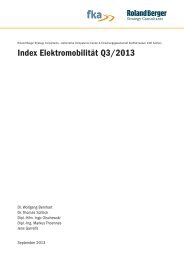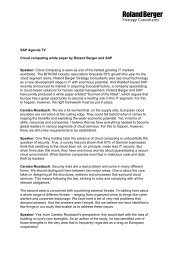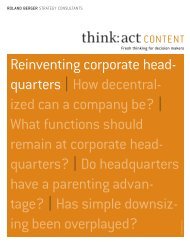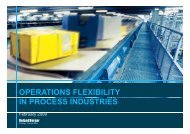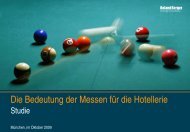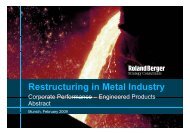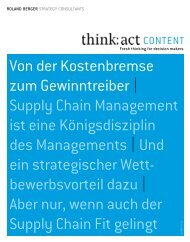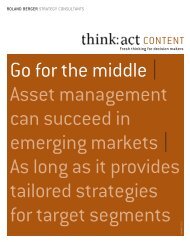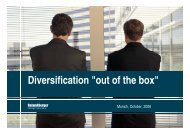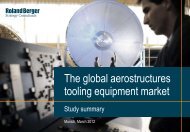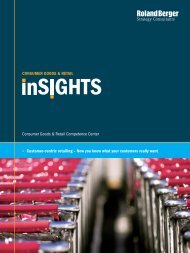Automotive engineering 2025 (PDF, 628 KB) - Roland Berger
Automotive engineering 2025 (PDF, 628 KB) - Roland Berger
Automotive engineering 2025 (PDF, 628 KB) - Roland Berger
You also want an ePaper? Increase the reach of your titles
YUMPU automatically turns print PDFs into web optimized ePapers that Google loves.
<strong>Roland</strong> <strong>Berger</strong> Strategy Consultants <strong>Automotive</strong> Competence Center<br />
<strong>Automotive</strong> Engineering <strong>2025</strong><br />
April 2011<br />
Dr. Wolfgang Bernhart<br />
Dr. Thomas Schlick<br />
1
Editorial<br />
Dear reader,<br />
In our recently published study, "<strong>Automotive</strong> <strong>2025</strong>", we gave an overview of megatrends<br />
which will heavily impact the automotive industry over the next 15 years.<br />
We described ten key findings based on these megatrends, the different scenarios<br />
and the key success factors common to them, to help management define their<br />
long-term strategy for<br />
> Markets, customers and products<br />
> Partnerships, business models and the value chain<br />
> Organizational structures, employees and necessary changes<br />
With this "<strong>Automotive</strong> Engineering <strong>2025</strong>", we take our findings to the next level<br />
and outline approaches for coping with the special challenges automotive <strong>engineering</strong><br />
is facing.<br />
We hope you find some time to read through this special edition and would be<br />
happy to discuss our perspectives and approaches with you in greater detail.<br />
Best regards,<br />
Ralf Kalmbach<br />
Head of Global<br />
<strong>Automotive</strong> Competence Center<br />
Dr. Wolfgang Bernhart<br />
Partner<br />
<strong>Automotive</strong> Competence Center<br />
2
A. "More with less" – five main challenges for automotive <strong>engineering</strong><br />
over the next 15 years<br />
Cars and systems "closely tailored to the demand for low cost and flexible enough<br />
to allow upgrades and personalization" – that's how we described future product and<br />
technology trends in our recent "<strong>Automotive</strong> <strong>2025</strong>" study [1]. "R&D will take place<br />
close to the market and local R&D centers will be connected by strong, flexible networks.<br />
Partnerships will grow in importance as a way of providing timely access to new<br />
technologies, markets and business models." This phenomenon will be independent<br />
from the different scenarios ("budget world", "sustainable world", "high tech world")<br />
that may develop.<br />
Let's first recap the main trends influencing automotive <strong>engineering</strong> over the<br />
next 15 years.<br />
> Sales and production will shift further to BRIC markets, but triad markets<br />
still account for over 40% of global sales and production<br />
> Clear distinction to other vehicles for individual mobility blurring;<br />
increasing importance of low-budget cars<br />
> Rise of new technologies (materials, electrification, connectivity)<br />
> Shortage of qualified employees, especially in traditional triad markets<br />
These trends will not only increase the complexity and amount of <strong>engineering</strong> work,<br />
but also call for "delivery at same cost". Before we discuss the resulting requirements<br />
to <strong>engineering</strong> organizations in detail, let's have a closer look at the above mentioned<br />
trends first.<br />
1. Further shift of sales and production to BRIC markets –<br />
New "lead markets" developing<br />
Sales and production will shift from triad markets especially to the BRIC countries,<br />
which will surpass the triad by between 2020 and <strong>2025</strong> in absolute production<br />
and sales figures (Fig. 1).<br />
Fig. 1:<br />
Sales<br />
Sales and production of light vehicles by region<br />
2000-<strong>2025</strong> [m units], "Base scenario"<br />
Production<br />
57 69 114<br />
11% 14% 11%<br />
11% 14%<br />
22%<br />
31%<br />
Other<br />
BRI<br />
China<br />
2.8<br />
6.8<br />
12.4<br />
57<br />
5%<br />
3% 6%<br />
69 114<br />
9% 8%<br />
11% 15%<br />
22%<br />
32%<br />
Other<br />
BRI<br />
China<br />
2.8<br />
6.7<br />
12.8<br />
80%<br />
86%<br />
53%<br />
44%<br />
Triad<br />
0.4<br />
59%<br />
44%<br />
Triad<br />
0.2<br />
3% 6% CAGR [%]<br />
2000<br />
2010<br />
<strong>2025</strong><br />
CAGR [%]<br />
2000<br />
2010<br />
<strong>2025</strong><br />
Source: <strong>Roland</strong> <strong>Berger</strong><br />
3
The emerging markets also have different product requirements: while emissions and<br />
safety standards are likely to converge, customer requirements remain different. Not<br />
only are they looking for a higher share of low-budget solutions, but car functionality<br />
will also see different requirements.<br />
At the 2011 Shanghai Motor Show, the first Chinese car will be shown featuring<br />
speech/audio-enabled online navigation, web access to stock prices, personalized<br />
points of interests, music stored "in the cloud" and RSS feeds.<br />
In <strong>2025</strong>, nearly a quarter of all Chinese car drivers will be younger than thirty, and<br />
only around 10% will be older than sixty. By contrast, only 6-7% of all drivers in Germany<br />
will be under thirty, while the share of elderly drivers (sixty years old or over) will<br />
increase to over a third of all drivers. These distinct groups have completely different<br />
priorities regarding ergonomics, comfort and driver assistance.<br />
Markets like China will therefore not only become more important from a sales and<br />
production perspective, but they will also become lead markets for specific technologies.<br />
Basic technologies are usually available in all markets, but differentiating<br />
know-how is being generated only by applying these technologies in <strong>engineering</strong> and<br />
production and interacting with the customer – "learning by doing" and "learning<br />
by using". As centers of economic growth shift and demographics change, new lead<br />
markets will arise. These lead markets are characterized by increased competitive<br />
intensity, which leads to better designs and faster cost reduction. Empirical studies<br />
show that companies actively innovating and developing in the lead markets are more<br />
successful than those who try to innovate from the home market only, usually with<br />
an ever-widening gap to their competition.<br />
Challenge 1: Successful innovation therefore means not only innovation at the right<br />
time, but also at the right place – managing a much higher regional complexity.<br />
2. Clear distinction to other vehicles for individual mobility blurring – Increasing<br />
importance of low-budget cars<br />
Increasing urbanization and the raise of megacities will lead to massive congestion<br />
problems. Coupled with increased environmental awareness, especially in Europe, new<br />
forms of mobility (such as car sharing concepts) as well as new means of individual<br />
transportation will increasingly gain significance.<br />
With new vehicles such as the Renault Twizy ZE (to be launched in 2012) or concept<br />
studies shown by GM at the Shanghai Expo in 2010, the portfolio of most car companies<br />
will be expanded to include very small vehicles – blurring the formerly clear line<br />
to single-track vehicles.<br />
At the same time, driven by the increasing share of new vehicle sales in emerging<br />
markets, low-budget solutions will become more important and a major source of<br />
future growth. To participate in that segment, automotive players need to integrate<br />
design effectiveness while leveraging low operating costs with a high share of<br />
localized parts (Fig. 2).<br />
4
Fig. 2:<br />
Leveraging cost advantages of local production is a "must" for<br />
low-budget solutions<br />
Local component supply<br />
Increasing local content is essential<br />
for optimizing production costs<br />
Transportation cost of selected<br />
components [EUR/unit 2) ]<br />
84%<br />
79%<br />
74%<br />
Cost of<br />
production [%] 1)<br />
Dashboard<br />
Front bumper<br />
31<br />
100<br />
45%<br />
55%<br />
65%<br />
Local<br />
content<br />
[value, %]<br />
Rear door<br />
Trunk<br />
19<br />
18<br />
Radiator grill<br />
8<br />
Drive shaft<br />
7<br />
Brake cylinder<br />
2<br />
1) Assumption: Cost of production = 100% if local content = 0<br />
2) Assumption: Distance 1,000 km by ship and truck, incl. packaging<br />
Radio<br />
1<br />
Source: <strong>Roland</strong> <strong>Berger</strong><br />
Challenge 2: Product requirements management will become much more complex –<br />
from the market, customer and product portfolio perspectives. Implementing local<br />
or locally adapted solutions will also increase requirements for localization.<br />
3. Rise of new technologies<br />
Revival of hydrogen fuel cell activities, increasing importance of lightweight materials,<br />
electrification of the powertrain, "always connected, always online" – these are just a<br />
few examples of the new technologies to be covered by OEMs in addition to their current<br />
technology portfolio. At the same time, OEMs need to invest in improving conventional<br />
technologies. Figure 3 shows an example of new technologies to be developed<br />
to improve the conventional combustion engine at current cost levels.<br />
Fig. 3:<br />
Cost development 1) gasoline engine over time – Example: 140 hp engine<br />
[EUR]<br />
250<br />
-250<br />
1,300<br />
400 1,700 -200 200<br />
• Turbo<br />
• Direct inject.<br />
• VVT<br />
• Var. pumps<br />
Downsizing<br />
(3 cyl.)<br />
Additional<br />
functions<br />
(BiVVT, VVL,<br />
2nd gen DI,<br />
etc.)<br />
1,700<br />
Lean Necessary<br />
(3rd gen DI, cost<br />
AGR, etc.) reduction<br />
1,700<br />
2005<br />
Line4 2.0l 16V<br />
2010<br />
Line4 1.6l Direkt,<br />
Turbo, VVT<br />
2015<br />
Line3 1.2l Direkt,<br />
Turbo, BiVVT, VVL<br />
2015+<br />
Line3 1.2l Lean,<br />
Turbo<br />
1) Installed costs, excl. R&D<br />
Source: <strong>Roland</strong> <strong>Berger</strong><br />
5
European OEMs alone need to invest another EUR 1.7 billion over the next 5 years to<br />
develop this functionality (Fig. 4). These costs need to be more than offset to free up<br />
budgets for alternative powertrain technologies.<br />
Fig. 4:<br />
Cost of engine development, EU OEMs<br />
2011-2016 (w/o application) [EUR bn]<br />
Increasing development costs<br />
1.7<br />
8.9<br />
Countermeasures<br />
-1.6<br />
7.2<br />
-1.6<br />
5.7<br />
-1.5<br />
Cumulated base<br />
development<br />
costs 1)<br />
Additional<br />
development<br />
costs 2)<br />
Development<br />
existing engine<br />
families (incl.<br />
replacements)<br />
Reduction of<br />
OEM engine<br />
families<br />
Common engine<br />
families (with<br />
partners)<br />
Target<br />
development<br />
efforts<br />
1) Combustion processes, variability, etc.<br />
Source: <strong>Roland</strong> <strong>Berger</strong><br />
Challenge 3: A much broader technology portfolio needs to be covered at current <strong>engineering</strong><br />
cost levels – new materials, electronics, electro-chemistry, information and<br />
communications technology, etc. At the same time, the understanding of the vehicle<br />
as part of a larger transportation and communications system needs to be improved.<br />
4. Shortage of qualified employees – especially in traditional triad markets<br />
As outlined above, regional, market, customer, product portfolio, technology and<br />
supply chain complexity will increase dramatically. This will result in demand for<br />
highly qualified workers – not only in traditional vehicle <strong>engineering</strong> disciplines, but<br />
also in adjacent skill areas, combined with intercultural skills. But statistics indicate<br />
a growing gap of qualified engineers and developers in mature markets – new talent<br />
sources need to be developed and integrated.<br />
Challenge 4: "War for talent" – <strong>Automotive</strong> <strong>engineering</strong> will need to compete with<br />
other industries for qualified employees, especially those with a strong background<br />
in <strong>engineering</strong> and other natural sciences. Relative wage levels may increase, and<br />
<strong>engineering</strong> needs to manage high (cultural) diversity.<br />
5. All of the above, while "delivering at same cost levels"<br />
While the complexity of automotive <strong>engineering</strong> will reach unprecedented levels, the<br />
industry as a whole needs to increase its financial performance to remain attractive<br />
to investors. As competition increases, there is little room to push price levels up.<br />
Costs therefore need to come down, and <strong>engineering</strong> will not be exempt.<br />
This leads us to the fifth, overarching challenge:<br />
Challenge 5: <strong>Automotive</strong> <strong>engineering</strong> needs to improve effectiveness and efficiency<br />
to deliver more at the same – or better yet, lower – cost levels than today's.<br />
6
B. "Effective global coverage" – Dominant requirement for the<br />
<strong>engineering</strong> organization of tomorrow<br />
To cope with these challenges, the <strong>engineering</strong> organization needs to be transformed<br />
from worldwide presence to worldwide integration. <strong>Automotive</strong> <strong>engineering</strong> needs to<br />
become "glocal", adapting a global framework to local particularities (Fig. 5).<br />
Fig. 5:<br />
Requirements for the <strong>engineering</strong> organization of tomorrow<br />
Regional<br />
complexity<br />
Market/customer/<br />
product portfolio<br />
complexity<br />
Technology/<br />
systems<br />
complexity<br />
"War for talent" –<br />
(cultural)<br />
diversity<br />
Effectiveness:<br />
"Delivery at same<br />
cost levels"<br />
From worldwide presence…<br />
… to worldwide integration<br />
• Multiregional locations<br />
• Centralization of development<br />
• Sequential launches of new products,<br />
based on centrally developed platforms<br />
• Dispersed production network<br />
• Local/regional purchasing bases,<br />
limited projects in partnerships with<br />
other OEMs<br />
• Multiregional integration<br />
• Network of development centers globally integrated<br />
though a competence center approach<br />
• Simultaneous launch of models, based on architectures<br />
and construction kits developed in lead markets<br />
• Standardized processes, combined with a superior level of output<br />
coordination and greater use of socialization and networks<br />
• Global purchasing base and broad partner network<br />
Source: <strong>Roland</strong> <strong>Berger</strong><br />
Local market know-how (both of customer and supply markets) needs to be seamlessly<br />
integrated with <strong>engineering</strong> competences in multiple locations. Trend scouting<br />
using dragnet methods such as the lead-user approach as well as traditional market<br />
research needs to take place in lead markets. If a specific technology is used broadly<br />
in a specific lead market, concept and prototype development should be done there<br />
as well. Centers of competence need to be defined accordingly, e.g.<br />
> India for low-budget solutions<br />
> Japan/East Asia for 3-D (online) navigation solutions<br />
> Brazil for alternative fuels<br />
> China or California for online infotainment solutions, etc.<br />
New products need to be launched nearly simultaneously on a global scale, based<br />
on architectures and construction kits developed and industrialized in the respective<br />
lead markets. To do so, a balanced approach of strong global coordination and local<br />
freedom is necessary.<br />
7
Most large automotive companies have already realized the need for global, multinational<br />
integration and consequently started to decentralize their development<br />
activities. This geographic dispersion is coupled with significant efforts to coordinate<br />
development activities. Our recently finished study [3] showed that such coordination<br />
is successful if it is rooted in a combination of two factors. The first is superior levels<br />
of output coordination (focusing on targeted outputs through plans, goals, monitoring<br />
and reporting systems rather than specific employee behavior).<br />
The second key factor is an increased use of socialization and networks. Socialization<br />
refers to encouraging employees to share a corporate culture that encompasses<br />
values, vision and mission. A common corporate culture shared by all employees<br />
is the key to managing diversity arising from the different (cultural) backgrounds<br />
of talent recruited from across the globe. Networks are used to promote the (nonhierarchical)<br />
sharing of information through formal relationships such as task forces,<br />
cross-functional teams and management transfers.<br />
And finally, <strong>engineering</strong> must focus on what is truly essential for the long-term success<br />
of the company. Effective <strong>engineering</strong> focuses on the aspects of products, accompanying<br />
services and technologies that really set the brand apart. This means:<br />
> Developing new in-house competences needed to gain competitive advantage<br />
> Shedding those in-house activities that do not lead to differentiation from<br />
competition, and rather partnering with others to improve economies of scale<br />
or to leverage each partner's specific strengths<br />
Transforming the <strong>engineering</strong> organization into a more focused globally integrated one,<br />
changing the culture to share a common vision and values, embracing diversity at the<br />
same time and entering into partnerships even with competitors – these are enormous<br />
tasks and require a structured approach.<br />
8
C. "<strong>Automotive</strong> <strong>engineering</strong> <strong>2025</strong>" – Five steps to manage the transformation<br />
into a highly effective glocal <strong>engineering</strong> organization<br />
Most automotive companies realize that they need more globally integrated development.<br />
However, most development employees – and hence most development<br />
work – are still located in the company's home region. Whereas basic development is<br />
often focused in one region (the home, and not necessarily the lead market), adaptive<br />
development is frequently located in two regions (the home and the largest foreign<br />
market).<br />
The need to cover a broader technology and product portfolio is well understood and<br />
the new skills needed for the future have been defined. However, determining what<br />
areas to shed is much more difficult and not always supported, especially by middle<br />
management, who tend to be skeptical regarding transferring competences to external<br />
partners.<br />
Increased diversity is stated as a goal, but in reality, a single nationality clearly<br />
dominates at most automotive companies, especially on VP and SVP levels. This<br />
is particularly true for OEMs.<br />
And last but not least, improving <strong>engineering</strong> effectiveness and efficiency is a clear<br />
objective – but how to attain that objective is unclear.<br />
To achieve these goals, we propose a five-step framework for managing the transformation<br />
into a highly effective glocal <strong>engineering</strong> organization (Fig. 6).<br />
Fig. 6:<br />
Framework for transforming the <strong>engineering</strong> organization<br />
1<br />
2<br />
3<br />
4<br />
5<br />
Develop a scenario-based product and technology roadmap<br />
and identify potential lead markets<br />
Define long-term requirements for the organization<br />
(core competencies/skills, regions, partners needed)<br />
Assess current status and identify gaps<br />
Define long-term roadmap (10 years) to close gaps<br />
Create short-term (3-year) action plan and set up an<br />
implementation organization to start transformation<br />
Source: <strong>Roland</strong> <strong>Berger</strong><br />
Before beginning with the first step, the company needs to clearly define its vision,<br />
mission, intended strategic position and overall business model.<br />
9
Once these have been firmly established, the first step is to develop a scenariobased<br />
product and technology roadmap. This roadmap should seek to link automotive<br />
macroscenarios (i.e. scenarios applicable to the entire industry) with companyspecific<br />
microscenarios. Companies need to identify potential lead markets based<br />
on the latter's market requirements, trends and economic demand. Once the lead<br />
markets have been identified, designs can be drafted and tailored to meet a market's<br />
unique profile.<br />
The second step is to define requirements for the organization: What will be its core<br />
competence(s)? What areas can be eliminated? In considering these and similar<br />
questions, one must take into account the predicted impact on the brand and/or the<br />
desired strategic position/business model. The target organizational set-up needs to<br />
be defined, e.g. (regional) centers of competence based on lead markets and other<br />
key features, target skills/headcount and ideal partnership structure.<br />
At this point, the company needs to figure out how far it is from the defined "ideal"<br />
organizational set-up. To do so, it must assess its current status, identify gaps and<br />
then derive high-level measures to close them.<br />
The measures for closing the gaps then need to be prioritized by synchronizing them<br />
with roadmaps (technologies, products, ..). When prioritizing the measures, companies<br />
must take into account uncertainties, impact on competitive position, availability of<br />
resources and economic levers.<br />
In the last step, a detailed improvement plan needs to be developed with a short-term<br />
(3-year) action plan. Finally, all that's left is to start the transformation.<br />
10
D. Summary and conclusion<br />
Over the next 15 years, the automotive industry will undergo the greatest transformation<br />
of its history. Complexity is rising everywhere, putting tremendous pressure on<br />
<strong>engineering</strong> organizations to become more effective, more efficient and faster. They<br />
also have to become more innovative as they will need to master a broader spectrum<br />
of technologies.<br />
The right setup is crucial – but it also takes time. To be prepared for the upcoming<br />
challenges, transformation needs to start now, and with a clear target picture in mind.<br />
Solid and profound know-how of the challenges ahead, a deep understanding of<br />
automotive <strong>engineering</strong> and hands-on experience in working in the automotive<br />
industry are necessary to add value in this process.<br />
That's what we have at <strong>Roland</strong> <strong>Berger</strong> – and we would be happy to support you<br />
in meeting these new challenges.<br />
Further reading:<br />
[1] Kalmbach, R.; Bernhart, W.; Grosse Kleimann, P.; Hoffmann, M.:<br />
<strong>Automotive</strong> landscape <strong>2025</strong>: Opportunities and challenges ahead<br />
Study, <strong>Roland</strong> <strong>Berger</strong> Strategy Consultants GmbH, Munich 2011<br />
[2] The next wave: Emerging market innovation – Threats and opportunities<br />
Study, <strong>Roland</strong> <strong>Berger</strong> Strategy Consultants GmbH, Munich 2007<br />
[3] Schmid, S.; Grosche, P.; Bernhart, W.; Schott, S.:<br />
Focus on corporate culture and networks – How automotive companies<br />
successfully coordinate their activities across borders.<br />
A survey of the automotive industry.<br />
ESCP Europe Business School & <strong>Roland</strong> <strong>Berger</strong> Strategy Consultants,<br />
Munich 2011<br />
11
Contact<br />
The authors welcome feedback and will be glad to<br />
address any questions.<br />
Dr. Wolfgang Bernhart<br />
Partner<br />
<strong>Roland</strong> <strong>Berger</strong> Strategy Consultants<br />
Löffelstraße 46<br />
70597 Stuttgart, Germany<br />
Phone: +49 (711) 3275-7421<br />
E-mail: Wolfgang_Bernhart@de.rolandberger.com<br />
Dr. Thomas Schlick<br />
Partner<br />
<strong>Roland</strong> <strong>Berger</strong> Strategy Consultants<br />
Bockenheimer Landstraße 2-8, OpernTurm<br />
60306 Frankfurt, Germany<br />
Phone: +49 (69) 29924-6202<br />
E-mail: Thomas_Schlick@de.rolandberger.com<br />
Co-authors:<br />
Max Blanchet<br />
Partner<br />
<strong>Roland</strong> <strong>Berger</strong> Strategy Consultants<br />
11, rue de Prony<br />
75017 Paris, France<br />
Phone: +33 (1) 53670-907<br />
E-mail: Max_Blanchet@fr.rolandberger.com<br />
Ralf Kalmbach<br />
Partner<br />
<strong>Roland</strong> <strong>Berger</strong> Strategy Consultants<br />
Mies-van-der-Rohe-Straße 6<br />
80807 München, Germany<br />
Phone: +49 (89) 9230-8669<br />
E-mail: Ralf_Kalmbach@de.rolandberger.com<br />
Dr. Satoshi Nagashima<br />
Partner<br />
<strong>Roland</strong> <strong>Berger</strong> Strategy Consultants<br />
1-12-32 Akasaka<br />
Tokyo 107-6023, Japan<br />
Phone: +81 (3) 358 76-683<br />
E-mail: Satoshi_Nagashima@jp.rolandberger.com<br />
Per M. Nilsson<br />
Partner<br />
<strong>Roland</strong> <strong>Berger</strong> Strategy Consultants<br />
Vasagatan 43 B<br />
41137 Gothenburg, Sweden<br />
Phone: +46 31 75755 - 10<br />
E-mail: Per-m_Nilsson@se.rolandberger.com<br />
Juergen Reers<br />
Partner<br />
<strong>Roland</strong> <strong>Berger</strong> Strategy Consultants<br />
2401 West Big Beaver Road, Suite 500<br />
Detroit, MI 48084, USA<br />
Phone: +1 248 729 - 5115<br />
E-mail: Juergen_Reers@us.rolandberger.com<br />
John Shen<br />
Partner<br />
<strong>Roland</strong> <strong>Berger</strong> Strategy Consultants<br />
23F Shanghai Kerry Center, 1515 Nanjing<br />
Shanghai 200040, China<br />
Phone: +86 (21) 52986677-874<br />
E-mail: Jun_Shen@cn.rolandberger.com<br />
12



